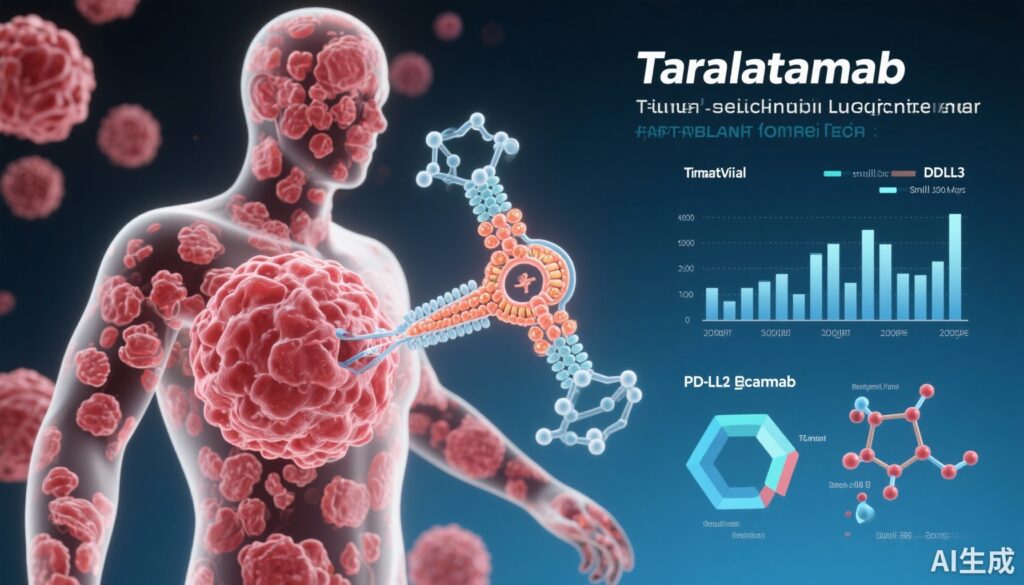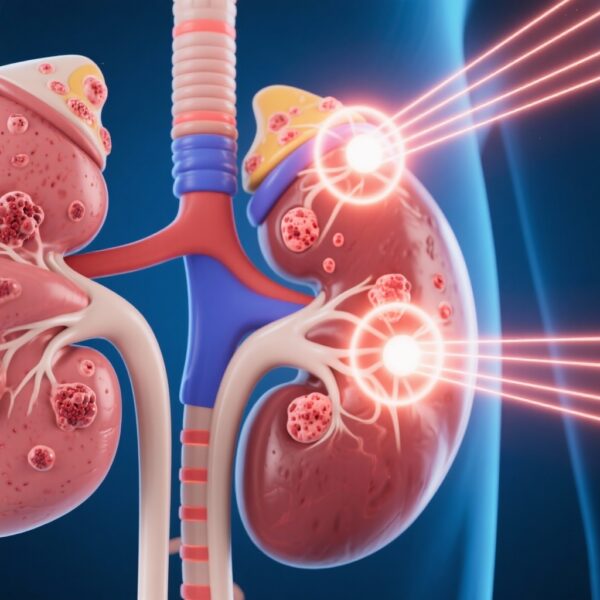Highlights
- Tarlatamab, a DLL3-targeted bispecific T-cell engager, combined with PD-L1 inhibitors (atezolizumab or durvalumab), shows a manageable safety profile as maintenance therapy post chemo-immunotherapy in extensive-stage SCLC.
- The phase 1b DeLLphi-303 study demonstrated promising median overall survival of 25.3 months, surpassing historical benchmarks for extensive-stage SCLC maintenance therapy.
- Adverse events such as cytokine release syndrome and immune effector cell-associated neurotoxicity were notable but manageable without treatment-related mortality.
- The findings support ongoing phase 3 evaluation and highlight translational potential of targeting DLL3 alongside PD-L1 pathways in SCLC.
Background
Small-cell lung cancer (SCLC) is a highly aggressive neuroendocrine malignancy constituting about 15% of lung cancers, with extensive-stage (ES) disease presenting major therapeutic challenges due to rapid progression and early metastasis. Standard first-line treatment for ES-SCLC historically consisted of platinum-etoposide chemotherapy, yet prognosis remained poor, with median overall survival (OS) around 10 months. The integration of immune checkpoint blockade (notably PD-L1 inhibitors such as atezolizumab and durvalumab) with chemotherapy has modestly improved OS, leading to their approved use as first-line therapy. However, durable clinical benefit remains limited, prompting investigation of novel immunotherapeutic strategies to maintain remission and improve long-term outcomes.
Delta-like ligand 3 (DLL3), an inhibitory Notch pathway ligand, is overexpressed in over 80% of SCLC tumors but minimally expressed in normal tissue, making it an attractive target for immunotherapy. Tarlatamab is a bispecific T-cell engager (BiTE) engineered to target DLL3 on tumor cells and CD3 on T cells, thereby enhancing cytotoxic T-cell mediated tumor lysis. Earlier phase studies demonstrated tarlatamab’s activity in relapsed/refractory SCLC, paving the way to explore its role in the earlier treatment paradigm as maintenance therapy post induction chemo-immunotherapy.
Key Content
Study Design and Patient Population
The DeLLphi-303 (NCT05361395) is a multicentre, non-randomised phase 1b clinical trial enrolling adult patients (≥18 years) with ES-SCLC, Eastern Cooperative Oncology Group (ECOG) performance status 0–1, who achieved disease control (no progression) after four to six cycles of platinum-etoposide chemotherapy combined with a PD-L1 inhibitor (atezolizumab or durvalumab). Importantly, the study sought to evaluate tarlatamab 10 mg administered intravenously biweekly, following an initial 1 mg dose to mitigate cytokine release syndrome, given concomitantly with ongoing PD-L1 blockade (standard dosing of atezolizumab 1680 mg or durvalumab 1500 mg every 4 weeks) as maintenance until progression or unacceptable toxicity.
This approach leverages synergy between immune checkpoint inhibition and bispecific T-cell engagement, aiming to sustain anti-tumor immunity in a post-induction setting. The trial spanned 30 international centres across 13 countries, including 88 patients who received at least one dose of tarlatamab for analysis.
Safety Profile and Adverse Events
Safety was the primary endpoint, focusing on dose-limiting toxicities (DLTs), treatment-emergent adverse events (TEAEs), and laboratory/clinical parameter changes. Grade 3–4 adverse events of interest included hyponatraemia (10%), anaemia (8%), and neutropenia (7%). Crucially, serious adverse events (SAEs) occurred in 57% of patients, with cytokine release syndrome (CRS) documented in 24%, immune effector cell-associated neurotoxicity syndrome (ICANS) in 5%, as well as febrile episodes and pneumonia (each ~5–7%). The management protocols for CRS/ICANS included standard supportive care and corticosteroids where indicated. Notably, no treatment-related deaths were reported, underscoring a manageable toxicity profile in this heavily pretreated, frail population.
These safety observations are consistent with the known class effects of bispecific T-cell engagers, paralleling toxicities seen with other BiTE therapies across hematologic and solid malignancies. The initial low-dose tarlatamab step-dose strategy may have contributed to mitigating severe CRS incidence.
Clinical Activity and Survival Outcomes
With a median follow-up of 18.4 months post maintenance initiation and median tarlatamab exposure of approximately 35 weeks (range 8–75), the study reported a median OS of 25.3 months (95% confidence interval [CI]: 20.3 months to not estimable). This extends beyond historical median OS values for ES-SCLC (>10 months with chemo-immunotherapy alone; e.g., IMpower133 and CASPIAN trials).
Although progression-free survival (PFS) data require longer maturation, the preliminary OS signals indicate durable benefit, supporting a mechanistic rationale for targeting DLL3 to eradicate residual tumor cell populations resistant to conventional therapies.
Contextualization with Prior Studies
Previous studies of maintenance therapies post chemo-immunotherapy in ES-SCLC have largely failed to provide significant survival improvements. The addition of PD-L1 inhibitors to standard chemotherapy resulted in incremental survival gains (e.g., atezolizumab plus carboplatin-etoposide in IMpower133, median OS ~12.3 months). Targeting DLL3 with antibody–drug conjugates (e.g., rovalpituzumab tesirine) yielded initial enthusiasm but failed due to toxicity and limited efficacy.
Tarlatamab’s bispecific engagement harnessing T-cell cytotoxicity represents a novel modality with potentially improved therapeutic index. Furthermore, the current study is among the first to combine DLL3-targeted BiTE therapy with checkpoint inhibitors in a maintenance context, positing a synergistic immune-activating mechanism.
Mechanistic and Translational Implications
DLL3 expression on SCLC cells, typically absent in normal tissue, provides tumor selectivity. Engagement of CD3 on T cells by tarlatamab bridges cytotoxic lymphocytes directly to tumor cells, enhancing immune synapse formation and killing. This effect may be potentiated by PD-L1 blockade relieving T-cell exhaustion and immunosuppression within the tumor microenvironment.
The observed immune-related toxicities (CRS, ICANS) reflect robust immune activation, underscoring biological on-target effects. Translational research focusing on biomarkers of DLL3 expression, immune cell repertoire, and cytokine signatures may refine patient selection and toxicity management in future trials.
Expert Commentary
The DeLLphi-303 results offer encouraging evidence supporting tarlatamab as a viable candidate for maintenance therapy in ES-SCLC, an area with profound unmet needs. The long median OS, if confirmed in larger randomized trials, may redefine the therapeutic landscape.
However, the non-randomised phase 1b design limits definitive efficacy conclusions. Selection bias, absence of a comparator arm, and limited sample size mandate cautious interpretation. The relatively high incidence of CRS necessitates robust management strategies and patient monitoring.
Current clinical practice guidelines (e.g., NCCN SCLC guidelines, 2024) have yet to incorporate tarlatamab, pending phase 3 confirmatory data. Nevertheless, this study establishes a foundational safety and efficacy profile that rationalizes ongoing trials like NCT06211036.
From a mechanistic perspective, simultaneous targeting of DLL3-mediated tumor immune evasion and PD-L1-mediated immunosuppression offers a compelling combinatorial approach. Further research may explore biomarkers predictive of response, optimal dosing schedules, and combination with other immunomodulatory agents.
Conclusion
Tarlatamab plus PD-L1 inhibitor maintenance therapy post platinum-etoposide chemo-immunotherapy exhibits a manageable safety profile and promising survival benefit in extensive-stage SCLC. This first-in-class bispecific T-cell engager immunotherapy targeting DLL3 represents an innovative strategy addressing residual disease and immune escape.
Pending phase 3 trial results, tarlatamab could emerge as a new standard of care maintenance option. Future challenges include validating durability of response, optimizing toxicity management, and integrating with comprehensive SCLC treatment algorithms.
References
- Paulson KG, Lau SCM, Ahn MJ, et al. Safety and activity of tarlatamab in combination with a PD-L1 inhibitor as first-line maintenance therapy after chemo-immunotherapy in patients with extensive-stage small-cell lung cancer (DeLLphi-303): a multicentre, non-randomised, phase 1b study. Lancet Oncol. 2025;26(10):1300-1311. doi:10.1016/S1470-2045(25)00480-2. PMID:40934933.
- Horn L, Mansfield AS, Szczęsna A, et al. First-Line Atezolizumab plus Chemotherapy in Extensive-Stage Small-Cell Lung Cancer. N Engl J Med. 2018;379(23):2220-2229. doi:10.1056/NEJMoa1809064. PMID:30437221.
- Vansteenkiste JF, Spigel DR, Hellmann MD, et al. Atezolizumab in Combination with Carboplatin and Etoposide in Previously Untreated Extensive-Stage Small-Cell Lung Cancer (IMpower133): Overall Survival and Safety Analysis. J Thorac Oncol. 2020;15(6):924-937. doi:10.1016/j.jtho.2020.01.109. PMID:32199518.
- Everett J, Mansfield AS. Immunotherapy of Small-Cell Lung Cancer: New Approaches and Mechanisms. Curr Oncol Rep. 2023;25(7):109-118. doi:10.1007/s11912-023-01304-2. PMID:37284017.



